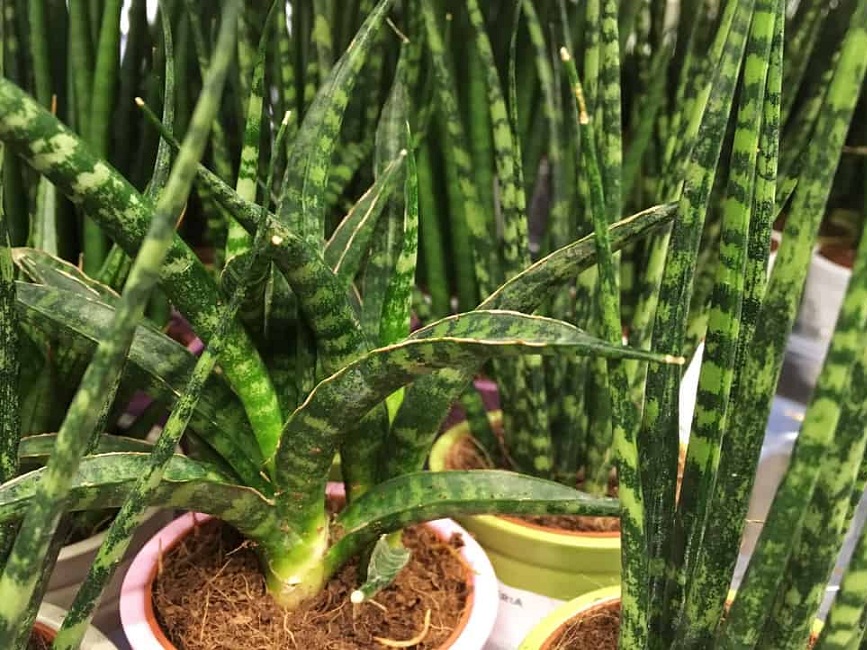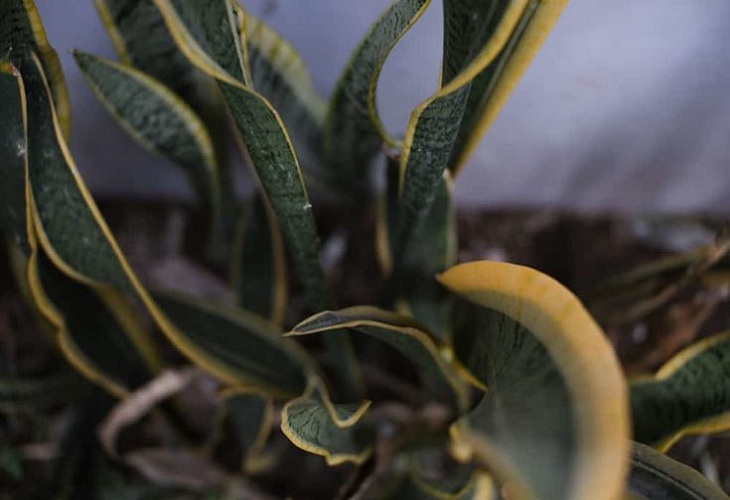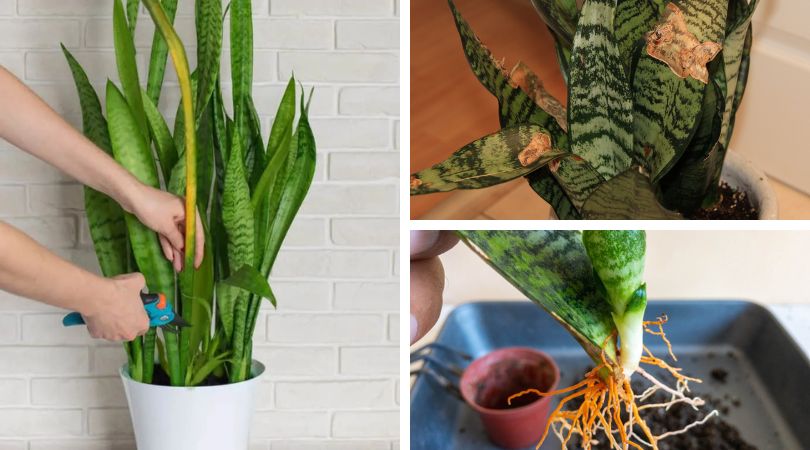Snake Plants (Sansevieria) are one of the most popular houseplants on the market, if not the most popular. Their structural shape, commonly referred to as mother-in-tongue, law’s is highly sought after, but they are mostly chosen for their ease of growth.
If you usually kill houseplants, this is the plant for you.
Many plant parents are surprised when they discover problems with their snake plant because of its extremely carefree nature. They are known to withstand a wide range of lighting conditions and can withstand a great deal of neglect. It’s hard to think of anything that could go wrong.
Unfortunately, your snake plants can suffer from a variety of issues, including drooping leaves, brown spots, and a lack of growth. Most, however, are simple to repair, and your snake plant should be back to normal in no time.
Drooping or bending leaves
Drooping or bending leaves could indicate a number of issues, the most common of which is overwatering.
If you overwater the plant, you may unintentionally cause root rot. The roots are not accustomed to sitting in water for extended periods of time and will begin to deteriorate if subjected to these conditions. When the roots are damaged, the plant’s ability to transport water and essential nutrients is compromised, resulting in bending leaves.
Underwatering, on the other hand, can also cause the leaves to droop. The plant cells in the leaves are filled with water, which keeps them strong and upright. Without water, the leaves thin out and can no longer support themselves, eventually falling over.
Adjust your watering schedule to solve this problem. Only water after the soil has dried out for several days – these plants prefer to be underwatered rather than overwatered.
If the roots are badly damaged, remove the plant from its pot and carefully cut off the damaged areas before repotting in new soil.
Less often, droopy leaves could be a sign of heat stress. While snake plants can tolerate full sun, too much can be harmful. If your snake plant is exposed to direct sunlight all day, especially in front of a window, relocate it to a location with more indirect bright light.

The leaves are narrow and stretched
When snake plants do not receive enough light, they begin to grow and stretch toward the nearest source of light. This stretching is known as etiolation, and it is the cause of extra-long, narrow, and thin leaves that are not only unsightly but also harmful to the plant.
The solution is straightforward: give your plant more light. Bright indirect light near a window should suffice, but these plants do prefer some direct sunlight during the day.
Unfortunately, once the leaves have grown in this manner, reverting the plant to its pre-etiolation growth and appearance will be difficult. If your plant is beyond repair, wait for shoots to form and repot them, or propagate it by taking cuttings from the healthiest-looking leaves.

The leaves are mushy and soft
Most of the time, soft, mushy leaves are a sign of too much water. Overwatering can cause the roots to rot and the leaves to fall over, but it can also cause too much moisture in the leaves and around the plant, causing them to rot. The insides of the leaves will gradually disintegrate and die, leaving behind a mushy texture.
Even if you water properly, the same problem can occur if your pot lacks adequate drainage. Most plants, but especially succulents like Sansevierias, require well-draining soil because they cannot be left in water.
Remove the plant from its original container and repot it in new, well-draining succulent soil. You can also make your own by combining potting soil and coarse sand to improve drainage. To encourage new, healthy growth, remove rotten roots and cut back damaged leaves.
If watering isn’t the problem, humidity might be. This is highly unlikely, as humidity levels high enough to cause mushy leaves are beyond most of us. However, if your snake plant is next to a humidifier or in a consistently moist bathroom, it is not impossible.
Remove the damaged leaves, relocate the plant to a drier location, and the plant should recover.

Deformed or misshapen leaves
If your leaves aren’t mushy or falling over, but something doesn’t seem right, you may have a pest infestation.
Small bugs, such as thrips or mites, can be difficult to detect. They are usually only noticed when signs of damage appear. These bugs sit on the plant’s leaves and in the soil, sucking the juices from within. This damage, especially if left untreated for an extended period of time, will end up causing the leaves to become deformed or misshapen.
Disease, while less common indoors, can also cause misshapen leaves. Various fungal diseases can settle on your plants in hot and humid weather, causing areas to rot and die off, resulting in deformation.
Always keep an eye out for signs of pest or disease problems when watering your plants. Pests can be controlled with natural homemade pesticides or horticultural oil, which can be purchased at your local nursery or online.
Unfortunately, fungal diseases are more difficult to treat. If the problem is not too severe, you can prune the affected plants or apply an organic fungicide to the leaves. If the disease becomes uncontrollable, you may need to remove the plant before it spreads to your other houseplants.

Brown spots or tips on the leaves
Brown spots or tips on the leaves are one of the more common snake plant problems, and unfortunately one of the more concerning ones. This issue also has several potential causes that you will need to investigate before determining the true culprit.
The first cause of brown spots is beyond your control – physical damage. If snake plant leaves are damaged, possibly due to bad weather or transportation, the affected area may turn brown. Unfortunately, you can’t do much about it because the injury has already occurred, however you can prune away the leaf to promote new, healthy growth.
The weather, specifically extreme temperatures, is the second cause. When exposed to frost, the cold freezes the plant’s cells, killing them once they thaw. This will result in brown spots wherever the damage occurred. Because those cells are no longer alive, they will not regenerate.
Extreme heat, on the other hand, can cause browning – this time at the tips. When your snake plant is overly exposed to sunlight, the ends of the leaves can burn, resulting in browning. This is most likely the cause of the problem if you recently moved your plant to a brighter location.
Brown patches on the leaves and at the tips can also be caused by nutrient deficiencies. While you may have good intentions when fertilizing your plants, using too much fertilizer can cause the roots to burn, resulting in brown tips. Nutrient deficiencies can also be caused by the use of tap water, which is frequently laced with treatment chemicals that the plants dislike.
Use fertilizer only when necessary and alternate your tap watering routine with filtered water on a regular basis to prevent chemical buildup.

The leaves are turning yellow
One of the most common houseplant issues is yellowing leaves. That isn’t always the case with Sansevierias (other problems usually appear first), but it’s not unheard of.
Overwatering is one of the worst things you can do to a snake plant, as you may have guessed. Roots that are left in water will rot, making it impossible for nutrients to reach parts of the plant that require them. This results in the yellowing leaves that all houseplant owners are familiar with.
Instead of watering on a regular basis, test the soil moisture with a meter or your finger once a week. Before watering again, allow the soil to dry almost completely.
Underwatering or inconsistent watering can cause the same issue. When you underwater, essential nutrients and water do not reach the leaves, causing them to turn yellow. Inconsistent watering – too much or too little watering all at once rather than a consistent, standard amount – can also cause plant stress and yellowing leaves.
Pests are also responsible for yellowing leaves, which are usually accompanied by other signs of damage such as brown spots or deformation. Remove the pests and prune the affected leaves, and the plant should return to normal.

The leaves are wrinkled
Snake plant leaves are typically dark in color and shiny and healthy-looking. If the leaves on your snake plant are wrinkled and dull, you know something is wrong.
There are several causes of wrinkled leaves, but the majority of them are temperature-related. If you have extremely hot weather for several days, your snake plant may become heat-stressed. The leaves will wrinkle as a result of the excessive heat and stress. Excessive sunlight can have the same effect.
Underwatering can also be indicated by wrinkled leaves. Although they prefer neglect, if you keep your Sansevieria underwatered for an extended period of time, it may respond by wrinkling due to a lack of water in the cells of the leaves to keep them plump. This is especially true in warmer weather, when pots dry out faster and plants require more care.
Resolving the issues should help your plant plump up and return to normal.
If you’ve recently purchased, relocated, or repotted your snake plant, wrinkled leaves could be an indication of stress. Plants do not like changes in their environment and may experience shock if they are moved around too much. It will take some time for the plant to adjust, but it should eventually return to normal.

Curling or twisting leaves
Most snake plants have broad, flat leaves, especially as they grow taller. Curling inward or outward leaves, or leaves twisting around each other, indicate a larger problem.
The root cause, as with the previous issue, is frequently underwatering. When the leaves are deprived of water for an extended period of time, they lose their characteristic upright shape and curl inwards to retain moisture. If this is accompanied by wrinkling or bending leaves, you can be fairly certain that the problem is caused by underwatering.
Curling leaves can also be caused by pests, particularly thrips. Leaf curl is one of the first signs of infestation, and if the problem is not treated, other problems such as browning or deformation will appear. To suffocate the pests, apply horticultural oil to the leaves and wipe them away with a cloth.
Another possible cause of curling leaves is overfertilization. These plants are not heavy feeders and will usually do fine without fertilizer, or with only one diluted dose applied once during the growing season. Too much fertilizer can damage the roots, resulting in curling leaves and browning, hardened edges.
Only use fertilizer when absolutely necessary, and always follow the directions. More fertilizer does not always result in greater growth.

Brown and mushy roots
If you’re repotting your snake plant and notice the roots are brown and mushy, don’t ignore the problem. Unresolved root problems will almost certainly result in the death of your plant, as the roots are critical to its survival.
Brown and mushy roots can be caused by two problems, the most common of which is overwatering. Watering issues can cause almost every problem on this list in some way, and this one is no exception.
When snake plant roots are left in water, they develop root rot, a fungal infection that disintegrates the tissue and prevents the plant from transporting essential water and nutrients. Always err on the side of not watering enough rather than overwatering, since the problems it causes, like root rot, can be hard to fix.
The second cause is disease, which is often associated with overwatering. Fungal diseases can live inside the soil and attack the roots, particularly in wet and humid conditions. Using garden soil to pot up your snake plant could result in this and a number of other problems. Garden soil is unsuitable for potting because it harbors disease and compacts easily, preventing water drainage.
If you have root problems, trim off all affected areas until the healthy growth is visible, rinse off any remaining soil, and repot in high-quality potting soil amended with sand to improve drainage.

The plant is not growing
The last issue may be difficult to detect because snake plants do not grow quickly, but it is a problem nonetheless. Inadequate growth is usually noticed after months or even years, so don’t be concerned if the leaves haven’t grown in a few days. However, if the plant suddenly stops growing or isn’t growing as much as it has in previous years, you may have a few problems.
The first issue is the pot’s size. Snake plants require repotting every couple of years, usually every three to five. If your plant has been in the same pot for several years and has stopped growing, it is most likely pot-bound. Repot into a larger pot and it should start growing again in no time.
The second most likely reason is a lack of sunlight. Plants require sunlight to photosynthesize, which allows them to grow larger. Your snake plant will not have enough energy to grow if it does not receive enough sunlight. Place it in a more sunny location (but not in direct sunlight) and see if that solves the problem.
Finally, a lack of growth may be due to a lack of nutrients in the soil. This usually occurs after repotting, but it could also occur if the plant was originally potted in soil with fewer nutrients. When a potted plant absorbs all of the nutrients from its soil, the soil becomes depleted and can no longer feed the plant. Apply a balanced liquid fertilizer to the soil, but be careful not to overfertilize.
Aside from these major issues, almost any problem can cause a lack of growth. Plant stress can be caused by improper watering, overfertilization, excessive sunlight exposure, or pest and disease problems. During stressful situations, the plant prioritizes survival over growth.
Examine the growing conditions to determine which cause is most likely, and then correct each one until the symptoms are gone.


